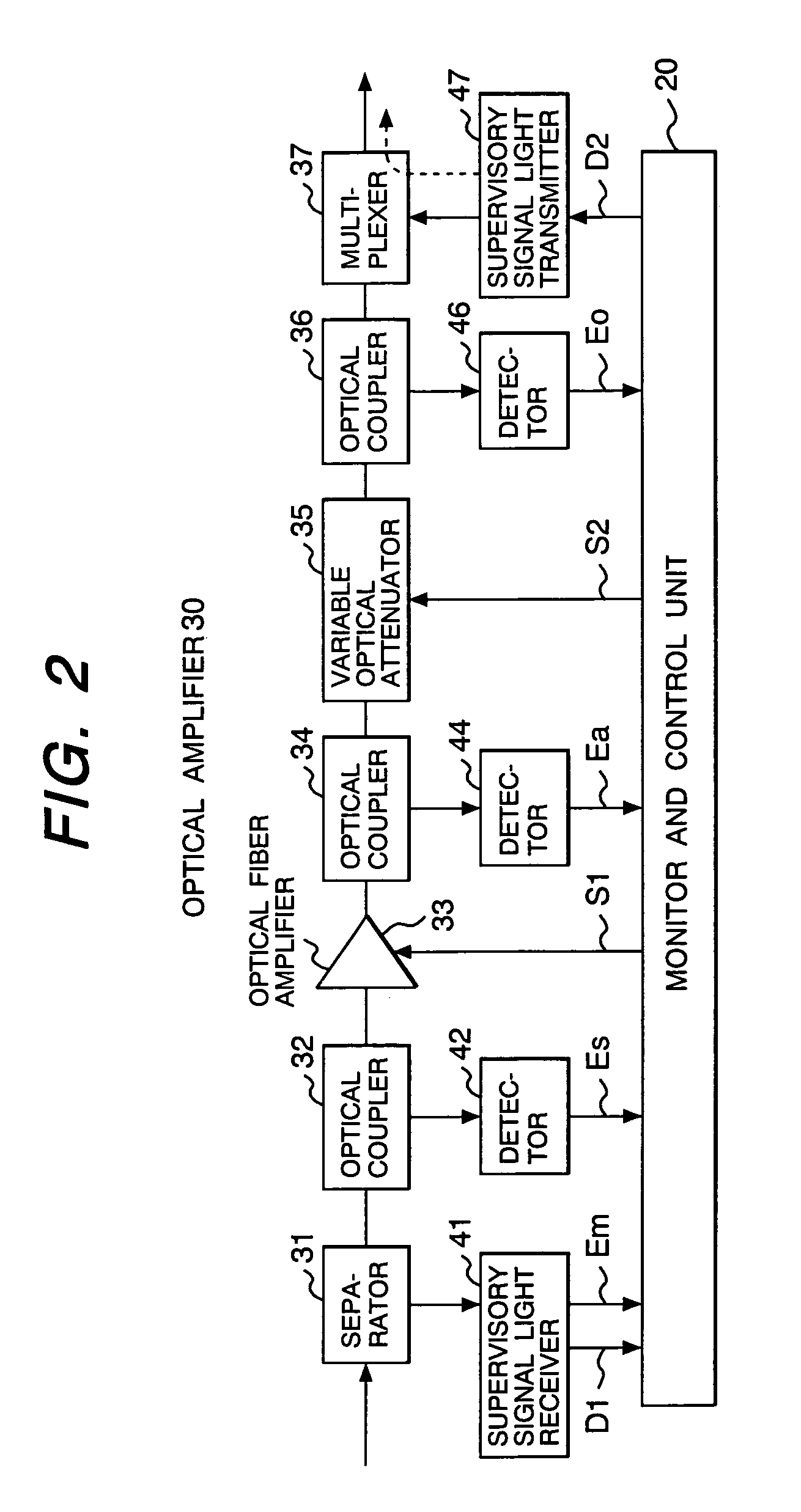Optical transmission apparatus and control method therefor
a transmission apparatus and optical fiber technology, applied in the direction of transmission monitoring, electromagnetic repeaters, multiplex communication, etc., can solve the problem of increasing the output optical power per signal light, the probability of a change is reduced, and the number of wavelengths physically multiplexed on the optical fiber cannot be achieved, so as to reduce the probability of a change, and ensure the quality of communication
- Summary
- Abstract
- Description
- Claims
- Application Information
AI Technical Summary
Benefits of technology
Problems solved by technology
Method used
Image
Examples
first embodiment
[0053]FIG. 2 shows an embodiment of the optical amplifier 30 to be mounted on the optical transmission apparatuses 1 of FIG. 1.
[0054]The optical amplifier 30 is provided with a separator 31 for separating the supervisory signal light from the optical input to the optical fiber, a first optical coupler 32 for branching part of the signal lights having passed the separator 31, an optical fiber amplifier 33 for optically amplifying signal lights within the signal light wavelength band having passed the optical coupler 32, a second optical coupler 34 for branching part of the output signal lights of the optical fiber amplifier 33, a variable optical attenuator 35 capable of freely adjusting the transmission losses of signal lights outputted from the optical coupler 34, a third optical coupler 36 for branching part of the output signal lights of the optical attenuator 35, a supervisory signal light transmitter 47, and a multiplexer 37 for multiplexing the supervisory signal light outputt...
second embodiment
[0087]In the first embodiment described above, as the monitor and control unit 20 terminates the supervisory signal light for every section of the optical fiber and a new supervisory signal light is transmitted to the next section from the supervisory signal light transmitter 47 as shown in FIG. 2, the monitor and control unit 20-3 of the optical transmission apparatus 1C shown in FIG. 1, for instance, cannot detect the presence or absence of any loss variation in the first optical fiber transfer section 2-1 and the extent of loss variation if it occurs. Therefore, when a loss variation occurs in the first optical fiber transfer section 2-1 and a variation is left in the signal light output power Eo because of incomplete compensation for the signal light output power Eo in the optical transmission apparatus 1B for some reason, optical signals manifesting a power variation beyond the permissible range may eventually be relayed to the transfer section 2-2. In this case, the monitor an...
third embodiment
[0092]The third embodiment is characterized in that, in the optical amplifier of FIG. 9, the power of a new supervisory signal light supplied from the supervisory signal light transmitter 47 is varied in proportion to the light power Ea of the amplified signal outputted from the optical fiber amplifier 33.
[0093]In this embodiment, the monitor and control unit 20 varies the control signal S3 according to the amplified signal light power Ea supplied from the detector 44, and the driving bias current of the laser diode 470 of the supervisory signal light transmitter 47 or the extent of attenuation of the optical attenuator 471 is controlled with this control signal S3. According to the embodiment, as the multiplexed signal light power and the supervisory signal light power are varying in association with each other at the time of output from the relaying optical transmission apparatus, there is no fear for the following optical transmission apparatus to mistake any fluctuation in the m...
PUM
 Login to View More
Login to View More Abstract
Description
Claims
Application Information
 Login to View More
Login to View More - R&D
- Intellectual Property
- Life Sciences
- Materials
- Tech Scout
- Unparalleled Data Quality
- Higher Quality Content
- 60% Fewer Hallucinations
Browse by: Latest US Patents, China's latest patents, Technical Efficacy Thesaurus, Application Domain, Technology Topic, Popular Technical Reports.
© 2025 PatSnap. All rights reserved.Legal|Privacy policy|Modern Slavery Act Transparency Statement|Sitemap|About US| Contact US: help@patsnap.com



